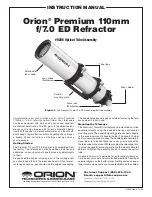
ShortTube
™
80mm
Refracting Telescope
#9386
Congratulations! Your new ShortTube
™
80mm Refractor is a
fine-quality instrument designed for both daytime terrestrial
viewing and nighttime stargazing. Compact, portable, and
easy to use, this versatile scope will provide many hours of
enjoyment for the whole family
.
WaRning:
Never look directly at the Sun without
a proper, professionally made solar filter that fits
over the front of the telescope. Doing so could cause
permanent eye damage or even blindness.
Parts List
Qty. Description
1
Optical tube assembly
2
1.25" eyepieces: 10mm Kellner and 25mm Kellner
1
45° correct-image diagonal, 1.25"
1
6x30 correct-image finder scope
1
Finder scope bracket and O-ring
1
Objective lens cap
getting Started
The ShortTube 80mm comes nearly fully assembled from the fac tory.
Open the box and inspect the contents to make sure all of the parts
listed above are present. Please keep the original shipping container
in case you should need to ship the telescope back to Orion for war-
ranty repair service. The box also makes a very good container for
storing the telescope when it is not in use.
The optics have been installed and collimated at the factory, so
you should not have to make any adjustments to them. To place
the finder scope in the finder scope bracket, first unthread the two
black nylon alignment screws until the screw ends are flush with the
inside diameter of the bracket. Place the O-ring that comes on the
base of the bracket over the body of the finder scope until it seats
into the slot on the middle of the finder scope. Slide the eyepiece
end (narrow end) of the finder scope into the end of the bracket’s
cylinder that does not have the alignment screws, while pulling the
spring-loaded tensioner on the bracket with your fingers. Push the
finder scope through the bracket until the O-ring seats just inside the
front opening of the bracket’s cylinder. Now, release the tensioner
and tighten the alignment screws a couple of turns each to secure
the finder scope in place. Secure the bracket to the “dovetail” mount
on the optical tube with the knurled thumb screw provided. Insert
the 45° diagonal into the focuser tube and secure with the knurled
thumb screw. Slide an eyepiece into the diagonal and gently tighten
the thumb screw.
Mounting the Telescope on a Tripod
The ShortTube 80mm can be mounted on any standard camera tri-
pod that has a 1/4"-20 stud. The stud threads into the small block
on the underside of the telescope’s optical tube. Alternatively, the
telescope can be attached to an equatorial mount equipped with a
1/4"-20 adapter. An equatorial mount is desirable for astronomical
viewing because it allows manual tracking of celestial objects as the
Earth rotates. Also, the setting circles on the mount enable you to
locate objects by their celestial coordinates (right ascension and
declination), which can be found in many books and star atlases.
Focusing
The ShortTube 80mm is equipped with a precision rack-and-pinion
focuser. When you first look in the eyepiece, the image you see may
be fuzzy, or out of focus. If so, gently turn one of the large focusing
wheels with your fingers until the image becomes sharp. You will
have to readjust the focus when aiming at subjects of varying dis-
tances, or after changing eyepieces. Make sure the focus lock screw
is loosened before focusing. After focusing, you can tighten it to lock
the telescope’s focus into place.
If, when looking through the finder scope, you notice that the image
is fuzzy, you will need to focus the finder scope for your eyes. This
is done by first loosening the lock ring that is located behind the
finder’s objective lens cell. Once the lock ring is loosened, thread
the objective lens cell in or out until the image appears sharp. Then,
retighten the lock ring behind the lens cell. The finder scope is now
focused, and should not need focusing again for your eyes.
aligning the Finder Scope
The ShortTube 80mm comes with a 6x30 finder scope. (The 6 means
six-times magnification, and the 30 indicates a 30mm- diameter front
lens.) Having a finder scope makes it easy to locate the subject you
want to observe with your telescope since it has a much wider field
of view. The finder scope and the telescope should be aligned so
that they both point to exactly the same spot.
Choose a tree, telephone pole, street sign—anything that is far off in
the distance, at least 200 yards away. Put that image in the center
of the field of your telescope’s eyepiece. Where is it in your finder
scope? Hopefully, the image will be in the field of view and some
simple adjustments of the two black nylon alignment screws on the
bracket will put the image dead center on the crosshairs. By loosen-
ing or tightening the alignment screws, you can change the line of
sight of the finder scope. Continue making adjustments to the two
alignment screws until the image in both the finder scope and the
telescope’s eyepiece is exactly centered. Check the alignment by
moving the telescope to another object and centering it on the find-
er’s crosshairs. Then look through the telescope’s eyepiece to see
if it is also centered in the telescope’s field of view. If it is, the job is
done. If not, make the necessary adjustments with the finder scope’s
alignment screws until the two images match up.
Finder scopes can come out of alignment during transport of the
telescope, so check the alignment before each observing session.
IN 068 Rev. B 0200
Providing Exceptional Consumer Optical Products Since 1975
Customer Support (800) 676-1343
E-mail: support@telescope.com
Corporate Offices (831) 763-7000
P.O. Box 1815, Santa Cruz, CA 95061
Dew cap/
lens shade
Optical
tube
Finder scope
Lock ring
Finder scope
alignment
screws
Finder scope
bracket
Focus
wheel
45° Diagonal
1/4"-20
Mounting
plate
Focus lock
screw
Rack-
and-pinion
focuser
Eyepiece




















